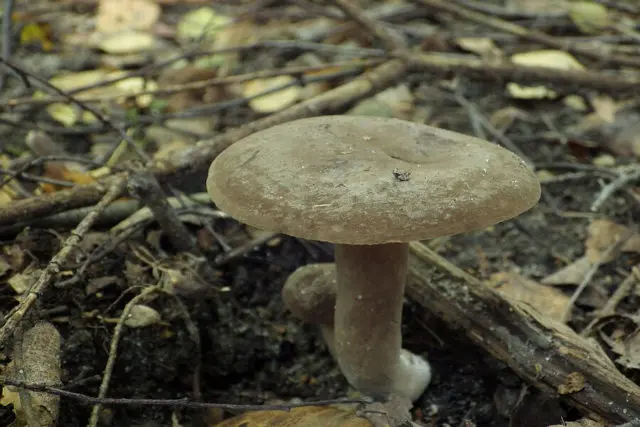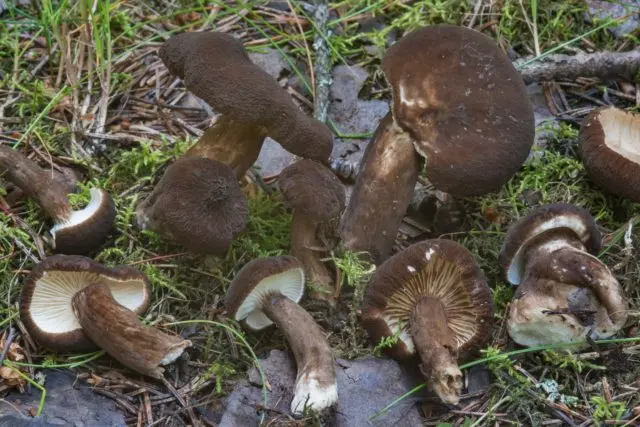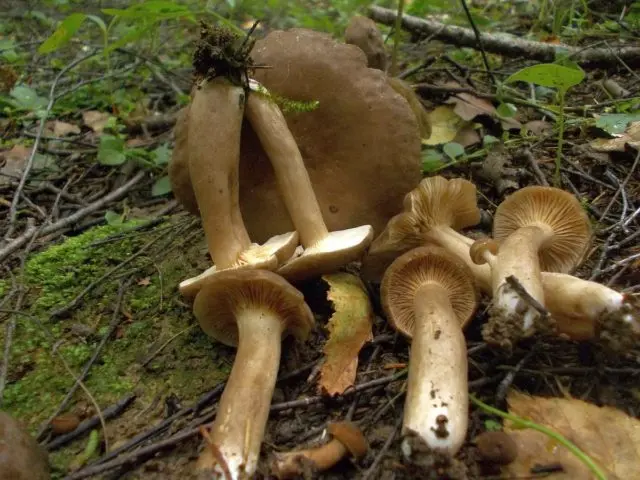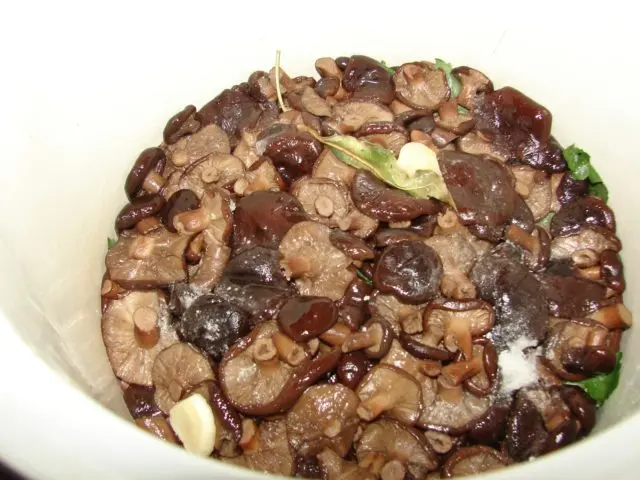Contents
Brownish Milkweed (Lactarius fuliginósus) is an agaric fungus from the Russula family, the Milky genus. Its other names:
- milky dark brown;
- sooty lactic;
- brownish champignon, since 1782;
- halorius brownish, since 1871;
- milky brownish, since 1891
Where does the milky mushroom grow brownish
The brown milky is distributed in the northern and temperate latitudes of Europe. In Our Country, it is quite rare. Prefers deciduous and mixed forests, birch forests, clearings, ravines. Likes shady damp places, grows singly and in small groups.
Begins to bear fruit in July and leaves in September.

Milky brownish forms a symbiosis with beech and oak
What does a brownish milky look like
Young fruiting bodies resemble neat buttons with rounded conical caps. The edges are strongly tucked inwards with a roller, a small tubercle stands out at the top. As it grows, the cap straightens first into an open-umbrella shape with edges bent down, then becomes disc-shaped, with straight edges or slightly concave. The tubercle in the center may be distinct or almost imperceptible, and an undulating depression is also traced. Sometimes the cap can give radial cracks. Grows from 2,5 to 9 cm.
The brownish milky has an almost uniform color – from sandy-beige to reddish-brown, the color of coffee with milk. In adult specimens, randomly located spots appear. The center could be darker. The surface is smooth, velvety, matte, sometimes covered with a light gray, ashy coating, dry.
The plates are thin, even, attached to the stem, sometimes descending. Creamy white in young mushrooms, then changing to a pinkish-coffee color. The pulp is thin, crisp, white-gray, then yellowish. There is a slight fruity aroma, the taste is neutral at first, then spicy. The juice is thick white, quickly turns red in the air. Pale spore powder.
The leg is relatively thick, even, cylindrical in shape. It grows from 1,8 to 6 cm, 0,5 to 2 cm thick. The color is brown, pale beige, white at the root. The surface is smooth, velvety, dry. Often the legs of several specimens grow together into one organism.

Brownish milkweed in a clearing in a mixed pine-beech forest
Is it possible to eat brown milky
The milky brownish is classified as a conditionally edible mushroom of the IV category. After a short soaking and heat treatment, it is suitable for preparing various dishes. It is mainly used for salting for the winter in hot, cold and dry ways.
False doubles
The brown milky is very similar to other representatives of its kind:
Milky resinous black. Conditionally edible. It differs in a more saturated color of the hat, the color of dark chocolate.

This species prefers to settle in coniferous and mixed forests, loves proximity to pines.
Milky brown (Lactarius lignyotus). Conditionally edible. His hat is darker, brown-brown, the hymenophore plates are wide. The color of the pulp at the break turns pink more slowly.

The mushroom grows mainly in coniferous forests.
Collection rules
You need to look for a brownish milky in wet lowlands, not far from water bodies, in places shaded by grass or low bushes. It is better to collect young specimens, they are tastier in salting and they do not have worms.
Carefully cut the found mushrooms with a knife at the root, pushing the forest floor, or turn them out in a circular motion. Place in the basket in rows, plates up, separating the large legs.

In adult specimens, the legs are hollow inside, in young specimens they are solid.
How to cook brown milky
Pick mushrooms. Throw away moldy, spoiled, wormy specimens. Clear from forest litter, cut off the roots. Large caps and legs cut into 2-4 parts. Brownish milky does not require long soaking, 1-2 days are enough:
- Mushrooms put in an enameled container.
- Pour cold water, press down with a lid with oppression so that all fruiting bodies remain under water.
- Change water twice a day.
After soaking, the mushrooms are ready for further processing.
Milky brownish fermented for the winter
This is an excellent appetizer for everyday and festive table. From salted mushrooms, you can cook pickles, bake pies and pizzas.
Ingredients:
- mushrooms – 2,8 kg;
- coarse gray salt – 150-180 g;
- sugar – 40 g;
- garlic – 6-10 cloves;
- dill stalks with umbrellas – 3-5 pieces;
- leaf of horseradish, oak, currant, cherry (which are available) – 4-5 pcs.;
- a mixture of peppercorns to taste.
Method of preparation:
- Mushrooms put in a saucepan, pour water, boil and cook over low heat for 15-20 minutes, removing the foam.
- Peel and rinse greens and garlic, prepare enameled dishes without chips – wash with soda and pour over boiling water.
- Lay the leaves and spices on the bottom, lay the mushrooms on them with plates up in rows, without squeezing.
- Sprinkle each layer with salt and sugar, lay leaves and spices between them.
- Lay the dill and horseradish last, press down with an inverted lid, a plate or a round wooden board, put a jar of water or a bottle on top.
- The weight of the oppression should be such that at least a centimeter of liquid comes out.
- Cover the dish with a clean cloth and put it in a cool place.
After a week, you can see how the fermentation process goes. If a musty smell appears, then there is not enough salt, it is necessary to add a solution of 40 g per 1 liter of water. You should also add water if there is not enough liquid on the surface. Once every 15 days, the contents should be pierced with a spatula or a skimmer handle to the bottom so that the liquid “plays”. The fermented milky brownish will be ready in 35-40 days.

If mold appears during the fermentation process, it must be removed.
Conclusion
Brownish milky is almost never found on the territory of Our Country. Its distribution area is the broad-leaved forests of Europe. He loves the neighborhood of oaks and beeches, settles in wet lowlands, floodplains, next to old swamps, in ravines and clearings. Of all milkers, it has the most delicate taste. You can collect it from July to September. It is mainly used for pickles or fermentation for the winter. It does not have poisonous twins; it differs from representatives of its own species by its quickly turning pink flesh and the mild taste of milky juice.









